The best bass anglers are always looking to up their game and learning new bass rigs is a sure-fire way to do that.
The Texas rig is the most common bass rig because it’s versatile and you can use it in combination with a lot of other styles.
I see a lot of professionals having success with drop-shotting as well.
If you’re serious about bass fishing and want to catch more, you should learn as many of them as possible.
With a combined 100 years of experience passed down to me, these rigs have been pummeled into my brain over my childhood and early adulthood.
I’ve got some new, some old, but they’re all good.
Let’s take a look!
If YouTube videos are more your style, here is a video of YourBassGuy.com writer Wes Littlefield breaking down these rigs.
Types of Bass Rigs
There are many reasons why it’s important to learn how to rig a fishing line and a lure.
Every rig has a different purpose.
Some are weedless, which means you can throw them near or in heavy cover, and you won’t pull back a ton of green.
Other bass rigs are for presentation.
They create a natural appearance of the lure, which helps increase the likelihood of bass being curious about what it is.
Regardless of what rig you prefer to use for bass, knowing the most popular bass rigs will give you more gas in the tank when you’re out there fishing a long day.
Carolina Rig
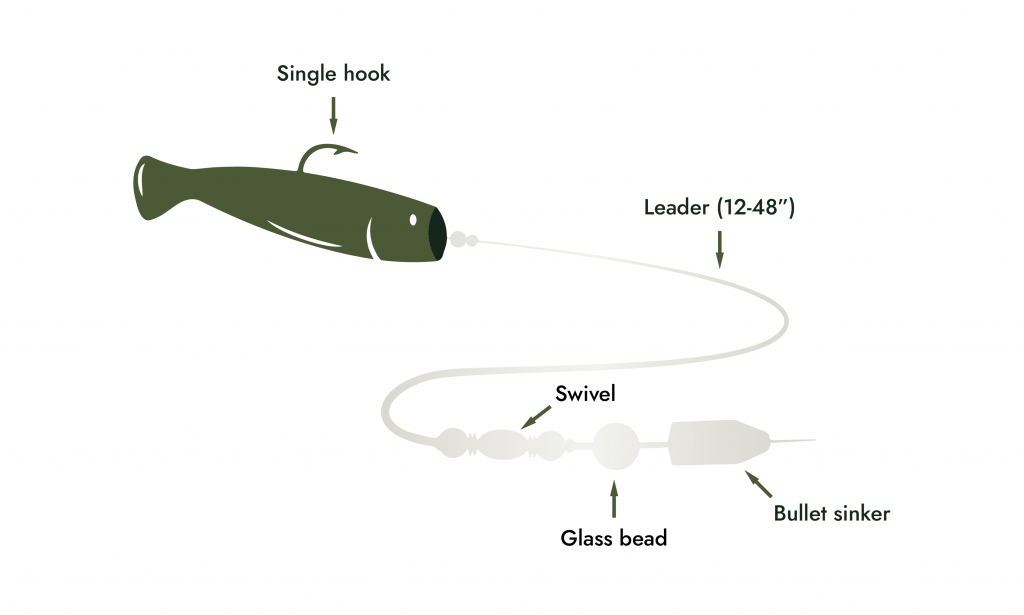
Fishing the Carolina rig for largemouth bass is about as common as fly fishing for trout.
If you’re unsure how to rig a Carolina worm properly, there’s no need to worry. The goal of this rig is to separate the weight from the worm because it can mess up your presentation.
If your weight is holding down your worm, it will ruin the action, which will tell the bass to stay away.
How to rig it?
First, you want to take a bullet sinker and slide it on your line with a bead or brass clacker behind it.
Attach a swivel to the end.
Now you’ll want to get about a four-foot leader and attach that to the swivel.
At the end of the leader is where you’ll attach your hook and then likely rig the worm Texas style.
As you can see – a Carolina rig has a lot less to do with the way you rig your lure and much more to do with the way you rig your line. It’s important to understand that a Carolina rig has nothing to do with the soft plastic bait.
Why do we like it?
It’s somewhat like a drop shot (we’ll get to that) because the goal is to keep the weight in constant contact with the bottom of the water.
What ends up happening is, the weight drags along the bottom with the four-foot leader suspending the lure above it.
So, you get the most natural presentation of the worm because it looks like it’s swimming along.
Plus, you also have a weedless presentation because you’re using a Texas rig. It’s a great rig for fishing the weeds and testing out the waters for stumps and rocks.
You don’t want to fish anywhere that’s too rocky because you’re looking for a more smooth base so you can glide along naturally.
Texas Rig
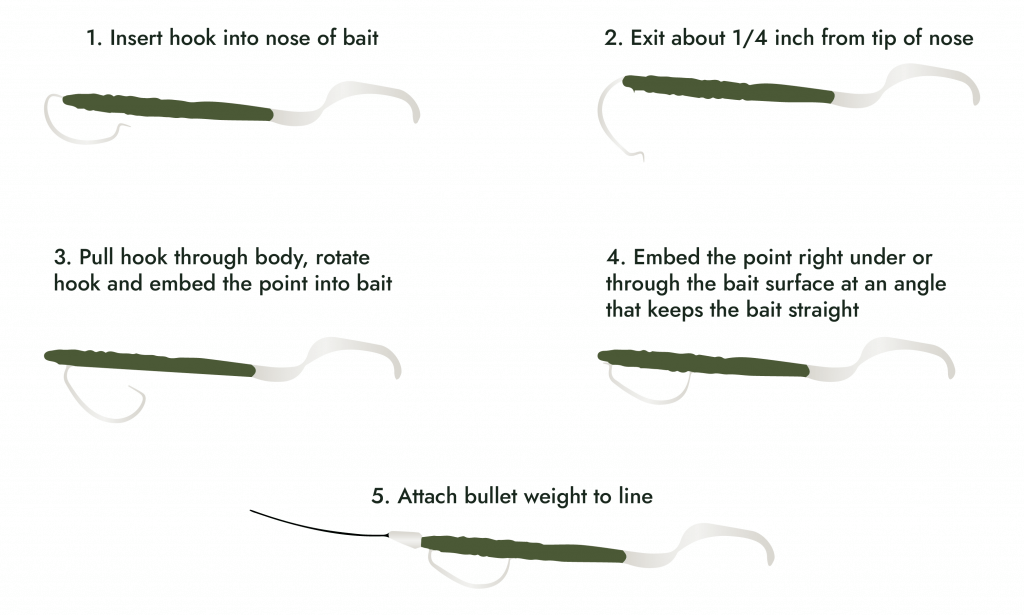
The Texas rig is one of the most popular bass rigs, and you can fish a wide assortment of soft plastics this way. You’ll use this weedless rig to help cast into heavy cover without bringing back a ton of vegetation into your boat.
How to rig it?
You’ll set this up by taking the hook and turning it around towards the worm.
Push about a quarter-inch of the hook into the worm, so it pokes out the other side. You want the hook at a perfect 90-degree angle.
Keep pushing the hook out until you reach the eyelet. You don’t want to expose it.
Remember that the most important part of this rig is protecting the tip of the hook from exposure to vegetation.
So, you want to push the end of the hook back into the worm if it pops out.
The first couple of times you do this, you’ll probably rip the worm, so I suggest testing it out on something you can afford to lose.
Why do we like it?
I like the Texas rig because it’s weedless.
It’s a great choice for anglers who like to fish in the danger zones and get closer to the tall grass than they should.
The good news is, this is where you find the big bass. If you see an opening in the grass, you can’t just throw anything in there because you’ll get hung up and end up having to cut your line.
With a Texas rig, that shouldn’t happen if you have it rigged correctly.
You have the choice of adding a sinker or fish it weightless. If you’re throwing it directly into the heavy vegetation, I would leave it weightless.
Drop Shot Rig
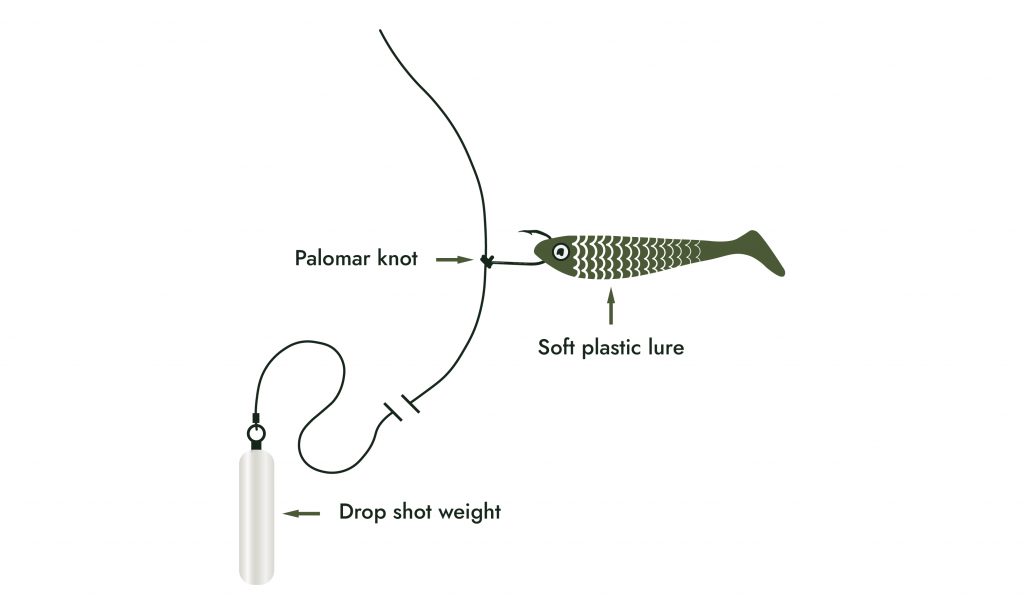
Everyone should learn how to use a drop shot rig for bass because this is the rig that most professionals use.
It’s got some similarities to the Carolina rig in terms of the way you present the lure and the function of the weight. The main difference is the location of the weight.
With a drop shot, your weight is at the end. The way you present your lure with a drop shot is also much different than the “dragging the bottom” strategy of a Carolina.
How to rig it?
To get started, you’ll start by stringing up your hook like you normally would. You want to leave about four feet of line at the end of the hook.
This will vary based on where you’re fishing.
If you’re fishing really shallow water, you can downsize that to one foot if you feel it’s necessary. I almost always leave around four feet, and it’s worked pretty well for me.
Next, you’ll tie your hook up, and now you have that extra line at the end.
Attach a drop shot or sinker to the end and boom; you’ve got yourself a drop shot.
Simple right?
Why do we like it?
There are many different strategies for fishing drop shots.
I would rig it up just like I said, use a Texas rigged worm, and simply drop it near weed beds and rows of tall grass.
The weight will stay at the bottom, and you can either drag it along or fish it vertically by jerking your rod tip and retrieving a revolution on the reel and repeating that process.
Regardless of which presentation you prefer, drop shots are really popular with professional anglers, and many have caught some incredible record-sized fish.
Wacky Rig
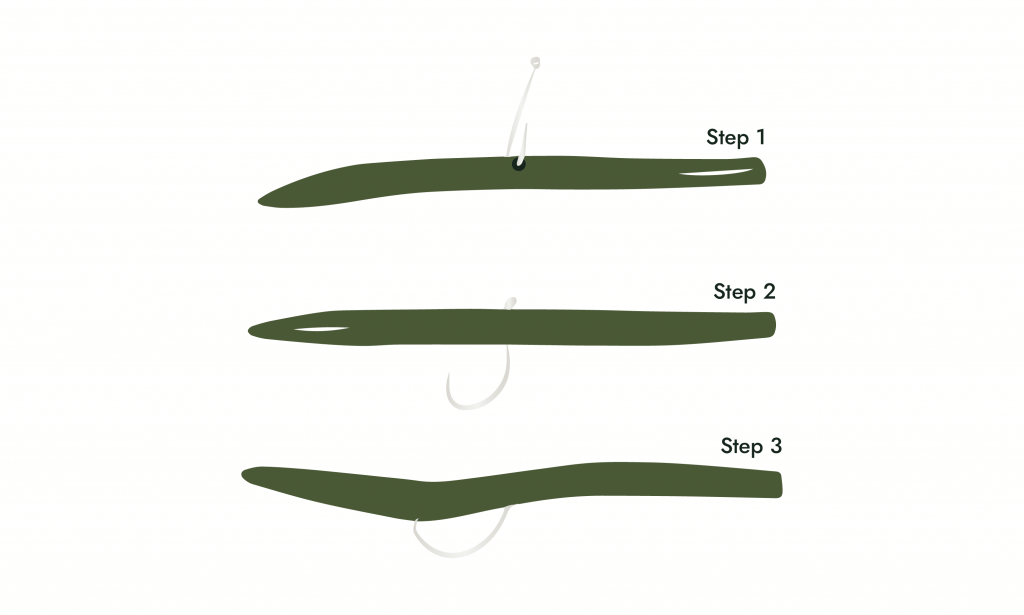
The wacky rig is one of my favorites for fishing open waters because I find it creates the most natural presentation, but it does have some downsides.
This fishing method is not weedless by any means, so you need to be much more careful when fishing around weeds and stumps.
It’s easy to rig, though, and doesn’t require as much gear.
How to rig it?
To rig wacky style, you’ll need a hook and a worm o-ring.
You’ll take the o-ring and wrap it around the worm and push it right towards the middle. It doesn’t have to be perfect, but I think right in the middle is the ideal location.
You also have the choice of piercing right through the worm, but I’ve found that this strategy causes the worms to crack and break apart prematurely.
I suggest using the o-rings and hooking them through there.
I’d suggest using a Yamamoto Senko or some form of Berkley Powerbait soft plastic lures for this rig. These are my favorite.
Why do we like it?
The presentation is simple. It’s a soft jerking motion, and you want to fish it vertically. You’ll cast the worm out and let it sink.
Once it’s almost towards the bottom, you need to tighten your line, work it back up, and fall again.
You’ll repeat this process over and over.
Some people prefer to put a weight in the middle to help it sink faster. I like a slower presentation with these.
Neko Rig
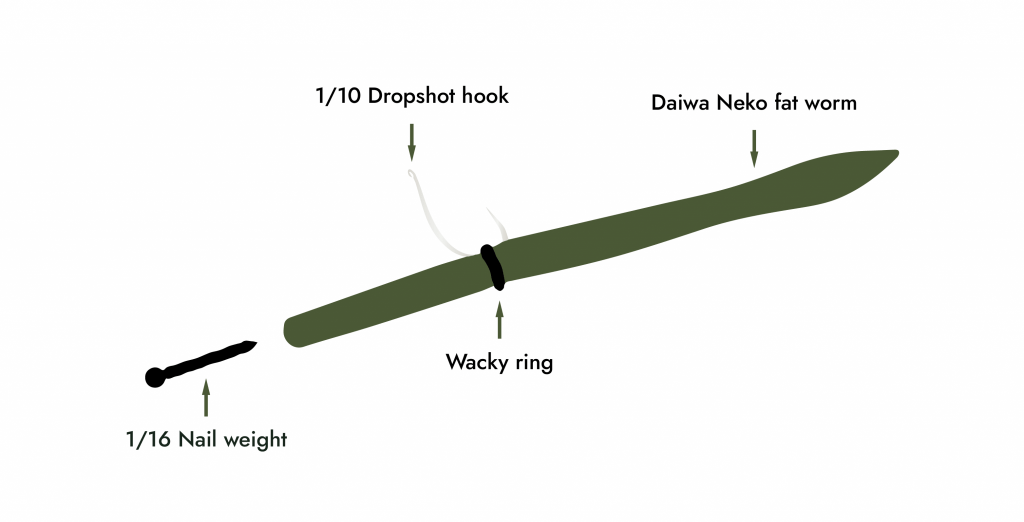
I’ve never been a huge fan of the Neko rig presentation because I’ve never really gotten the purpose.
That said, I know many anglers who are killing it with this bass fishing rig setup.
It’s essentially a wacky rig with a weight at the end instead of the middle, that’s all we’re doing.
How to rig it?
It’s simple. Pierce the worm in the middle or use an o-ring as we did with the wacky rig.
Take a lead weight nail and insert it into the blunt tail end of the worm.
So, when you present this worm, it will stand vertically, but with each movement, it will pull horizontally and then return to vertical when you let it sink.
Why do we like it?
My favorite thing about this rig is the fact that you can buy special Neko rig weights, not which make it much easier.
They come with a nail, and you insert it to the top of the worm, and you’re good to go.
As I said, I don’t have a ton of experience with this rig, but I know a lot of people who swear by it. It’s also very similar to the chicken rig which is another popular option for bass fishing.
Give it a shot!
Ned Rig
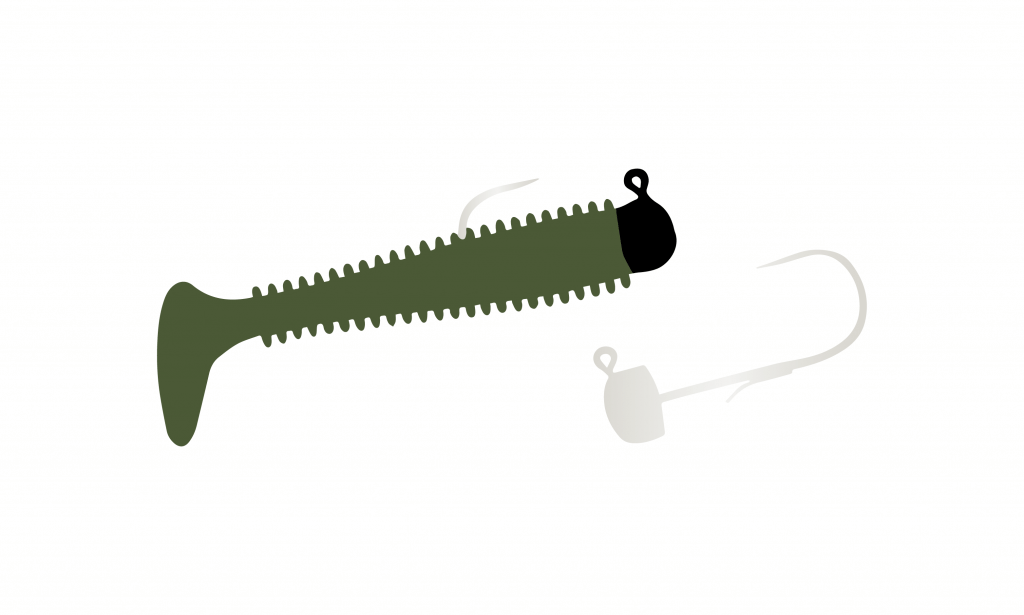
The ned rig is one of the simplest types of bass fishing rigs, and you’ve likely fished this before without even knowing you were rigging a soft plastic.
It’s a great strategy for when the bass aren’t biting during the cold winter months.
Their metabolism slows down during the winter, so you’ll want to deploy this strategy for winter bass fishing.
How to rig it?
Take your soft plastic and insert a jig head into it.
Make sure to size down if you’re fishing during cold weather months because the bass isn’t willing to accept a challenge during this time. Many people prefer a mushroom jig head.
Then you want to attach that setup to a six-foot fluorocarbon leader.
Tie it up using your favorite knot, and you’ve got yourself a ned rig.
See, I told you it was simple!
All you really have here is a typical jig setup.
Why do we like it?
It’s a great choice for cold-water fishing because it’s simple, small, and ideal for finesse angling.
You’ll want to work it up and down like a standard jig and be sure to fish shallow waters with the ned rig because bass will retreat there when the water temperature starts to drop.
Shaky Head
If you’re unsure if you should use a Shaky Head or Texas rig, this Youtube video by YourBassGuy.com Community Coordinator Wesley Littlefield will help!
The shaky head rig for bass fishing is similar to the ned rig, but it uses a different kind of head.
The presentation is still intended for when bass aren’t biting, but you can use it at any time.
Instead of using a mushroom jig, you’ll use a round head and rig it Texas-style. It creates a natural presentation that the bass can’t resist.
How to rig it?
This one is super simple.
The rig consists of a soft plastic worm like a Senko. They even have dedicated “shakey head” worms now that you can buy.
Whatever choice you make, it doesn’t really matter.
Take your jig head and penetrate the worm and wrap the hook all the way around so you can stick the end back through the bottom of the worm for a Texas rig.
Why do we like it?
I like it because it’s weedless and the presentation is spot on. Keep in mind that you can modify this rig with a drop shot as well to create an even more natural action.
Common Components of a Bass Rig
So, if you’re sitting at your computer staring at the screen or you’re scrolling through this article at the tackle shop – you might be wondering what gear you need for all these rigs. Here’s a comprehensive breakdown of all the things you’ll need to buy for each rig on this list.
- Fluorocarbon leader (approximately eight pounds)
- Monofilament line
- Bullet or egg sinkers
- Bead weights or brass clackers
- Swivels
- 1-2 hooks, drop shot hooks, wacky hooks
- Variety of soft plastics including Senko worms and powerbait of varying sizes
- Shakey head jigs and mushroom jigs
Stock up on all of this gear, and you should be good to go!
Final Thoughts
Think you know everything about bass rigs now? You’re pretty darn close to it. These are the most effective and most common bass rigs out there right now. You’ll see many professional anglers use the drop shot, Texas, and Carolina rigs regularly. Pair these rigs with the best bass fishing techniques and catch more bass!
yourbassguy.comThe best bass anglers are always looking to up their game and learning new bass rigs is a sure-fire way to do that.
The Texas rig is the most common bass rig because it’s versatile and you can use it in combination with a lot of other styles.
I see a lot of professionals having success with drop-shotting as well.
If you’re serious about bass fishing and want to catch more, you should learn as many of them as possible.
With a combined 100 years of experience passed down to me, these rigs have been pummeled into my brain over my childhood and early adulthood.
I’ve got some new, some old, but they’re all good.
Let’s take a look!
If YouTube videos are more your style, here is a video of YourBassGuy.com writer Wes Littlefield breaking down these rigs.
Types of Bass Rigs
There are many reasons why it’s important to learn how to rig a fishing line and a lure.
Every rig has a different purpose.
Some are weedless, which means you can throw them near or in heavy cover, and you won’t pull back a ton of green.
Other bass rigs are for presentation.
They create a natural appearance of the lure, which helps increase the likelihood of bass being curious about what it is.
Regardless of what rig you prefer to use for bass, knowing the most popular bass rigs will give you more gas in the tank when you’re out there fishing a long day.
Carolina Rig

Fishing the Carolina rig for largemouth bass is about as common as fly fishing for trout.
If you’re unsure how to rig a Carolina worm properly, there’s no need to worry. The goal of this rig is to separate the weight from the worm because it can mess up your presentation.
If your weight is holding down your worm, it will ruin the action, which will tell the bass to stay away.
How to rig it?
First, you want to take a bullet sinker and slide it on your line with a bead or brass clacker behind it.
Attach a swivel to the end.
Now you’ll want to get about a four-foot leader and attach that to the swivel.
At the end of the leader is where you’ll attach your hook and then likely rig the worm Texas style.
As you can see – a Carolina rig has a lot less to do with the way you rig your lure and much more to do with the way you rig your line. It’s important to understand that a Carolina rig has nothing to do with the soft plastic bait.
Why do we like it?
It’s somewhat like a drop shot (we’ll get to that) because the goal is to keep the weight in constant contact with the bottom of the water.
What ends up happening is, the weight drags along the bottom with the four-foot leader suspending the lure above it.
So, you get the most natural presentation of the worm because it looks like it’s swimming along.
Plus, you also have a weedless presentation because you’re using a Texas rig. It’s a great rig for fishing the weeds and testing out the waters for stumps and rocks.
You don’t want to fish anywhere that’s too rocky because you’re looking for a more smooth base so you can glide along naturally.
Texas Rig

The Texas rig is one of the most popular bass rigs, and you can fish a wide assortment of soft plastics this way. You’ll use this weedless rig to help cast into heavy cover without bringing back a ton of vegetation into your boat.
How to rig it?
You’ll set this up by taking the hook and turning it around towards the worm.
Push about a quarter-inch of the hook into the worm, so it pokes out the other side. You want the hook at a perfect 90-degree angle.
Keep pushing the hook out until you reach the eyelet. You don’t want to expose it.
Remember that the most important part of this rig is protecting the tip of the hook from exposure to vegetation.
So, you want to push the end of the hook back into the worm if it pops out.
The first couple of times you do this, you’ll probably rip the worm, so I suggest testing it out on something you can afford to lose.
Why do we like it?
I like the Texas rig because it’s weedless.
It’s a great choice for anglers who like to fish in the danger zones and get closer to the tall grass than they should.
The good news is, this is where you find the big bass. If you see an opening in the grass, you can’t just throw anything in there because you’ll get hung up and end up having to cut your line.
With a Texas rig, that shouldn’t happen if you have it rigged correctly.
You have the choice of adding a sinker or fish it weightless. If you’re throwing it directly into the heavy vegetation, I would leave it weightless.
Drop Shot Rig

Everyone should learn how to use a drop shot rig for bass because this is the rig that most professionals use.
It’s got some similarities to the Carolina rig in terms of the way you present the lure and the function of the weight. The main difference is the location of the weight.
With a drop shot, your weight is at the end. The way you present your lure with a drop shot is also much different than the “dragging the bottom” strategy of a Carolina.
How to rig it?
To get started, you’ll start by stringing up your hook like you normally would. You want to leave about four feet of line at the end of the hook.
This will vary based on where you’re fishing.
If you’re fishing really shallow water, you can downsize that to one foot if you feel it’s necessary. I almost always leave around four feet, and it’s worked pretty well for me.
Next, you’ll tie your hook up, and now you have that extra line at the end.
Attach a drop shot or sinker to the end and boom; you’ve got yourself a drop shot.
Simple right?
Why do we like it?
There are many different strategies for fishing drop shots.
I would rig it up just like I said, use a Texas rigged worm, and simply drop it near weed beds and rows of tall grass.
The weight will stay at the bottom, and you can either drag it along or fish it vertically by jerking your rod tip and retrieving a revolution on the reel and repeating that process.
Regardless of which presentation you prefer, drop shots are really popular with professional anglers, and many have caught some incredible record-sized fish.
Wacky Rig

The wacky rig is one of my favorites for fishing open waters because I find it creates the most natural presentation, but it does have some downsides.
This fishing method is not weedless by any means, so you need to be much more careful when fishing around weeds and stumps.
It’s easy to rig, though, and doesn’t require as much gear.
How to rig it?
To rig wacky style, you’ll need a hook and a worm o-ring.
You’ll take the o-ring and wrap it around the worm and push it right towards the middle. It doesn’t have to be perfect, but I think right in the middle is the ideal location.
You also have the choice of piercing right through the worm, but I’ve found that this strategy causes the worms to crack and break apart prematurely.
I suggest using the o-rings and hooking them through there.
I’d suggest using a Yamamoto Senko or some form of Berkley Powerbait soft plastic lures for this rig. These are my favorite.
Why do we like it?
The presentation is simple. It’s a soft jerking motion, and you want to fish it vertically. You’ll cast the worm out and let it sink.
Once it’s almost towards the bottom, you need to tighten your line, work it back up, and fall again.
You’ll repeat this process over and over.
Some people prefer to put a weight in the middle to help it sink faster. I like a slower presentation with these.
Neko Rig

I’ve never been a huge fan of the Neko rig presentation because I’ve never really gotten the purpose.
That said, I know many anglers who are killing it with this bass fishing rig setup.
It’s essentially a wacky rig with a weight at the end instead of the middle, that’s all we’re doing.
How to rig it?
It’s simple. Pierce the worm in the middle or use an o-ring as we did with the wacky rig.
Take a lead weight nail and insert it into the blunt tail end of the worm.
So, when you present this worm, it will stand vertically, but with each movement, it will pull horizontally and then return to vertical when you let it sink.
Why do we like it?
My favorite thing about this rig is the fact that you can buy special Neko rig weights, not which make it much easier.
They come with a nail, and you insert it to the top of the worm, and you’re good to go.
As I said, I don’t have a ton of experience with this rig, but I know a lot of people who swear by it. It’s also very similar to the chicken rig which is another popular option for bass fishing.
Give it a shot!
Ned Rig

The ned rig is one of the simplest types of bass fishing rigs, and you’ve likely fished this before without even knowing you were rigging a soft plastic.
It’s a great strategy for when the bass aren’t biting during the cold winter months.
Their metabolism slows down during the winter, so you’ll want to deploy this strategy for winter bass fishing.
How to rig it?
Take your soft plastic and insert a jig head into it.
Make sure to size down if you’re fishing during cold weather months because the bass isn’t willing to accept a challenge during this time. Many people prefer a mushroom jig head.
Then you want to attach that setup to a six-foot fluorocarbon leader.
Tie it up using your favorite knot, and you’ve got yourself a ned rig.
See, I told you it was simple!
All you really have here is a typical jig setup.
Why do we like it?
It’s a great choice for cold-water fishing because it’s simple, small, and ideal for finesse angling.
You’ll want to work it up and down like a standard jig and be sure to fish shallow waters with the ned rig because bass will retreat there when the water temperature starts to drop.
Shaky Head
If you’re unsure if you should use a Shaky Head or Texas rig, this Youtube video by YourBassGuy.com Community Coordinator Wesley Littlefield will help!
The shaky head rig for bass fishing is similar to the ned rig, but it uses a different kind of head.
The presentation is still intended for when bass aren’t biting, but you can use it at any time.
Instead of using a mushroom jig, you’ll use a round head and rig it Texas-style. It creates a natural presentation that the bass can’t resist.
How to rig it?
This one is super simple.
The rig consists of a soft plastic worm like a Senko. They even have dedicated “shakey head” worms now that you can buy.
Whatever choice you make, it doesn’t really matter.
Take your jig head and penetrate the worm and wrap the hook all the way around so you can stick the end back through the bottom of the worm for a Texas rig.
Why do we like it?
I like it because it’s weedless and the presentation is spot on. Keep in mind that you can modify this rig with a drop shot as well to create an even more natural action.
Common Components of a Bass Rig
So, if you’re sitting at your computer staring at the screen or you’re scrolling through this article at the tackle shop – you might be wondering what gear you need for all these rigs. Here’s a comprehensive breakdown of all the things you’ll need to buy for each rig on this list.
- Fluorocarbon leader (approximately eight pounds)
- Monofilament line
- Bullet or egg sinkers
- Bead weights or brass clackers
- Swivels
- 1-2 hooks, drop shot hooks, wacky hooks
- Variety of soft plastics including Senko worms and powerbait of varying sizes
- Shakey head jigs and mushroom jigs
Stock up on all of this gear, and you should be good to go!
Final Thoughts
Think you know everything about bass rigs now? You’re pretty darn close to it. These are the most effective and most common bass rigs out there right now. You’ll see many professional anglers use the drop shot, Texas, and Carolina rigs regularly. Pair these rigs with the best bass fishing techniques and catch more bass!


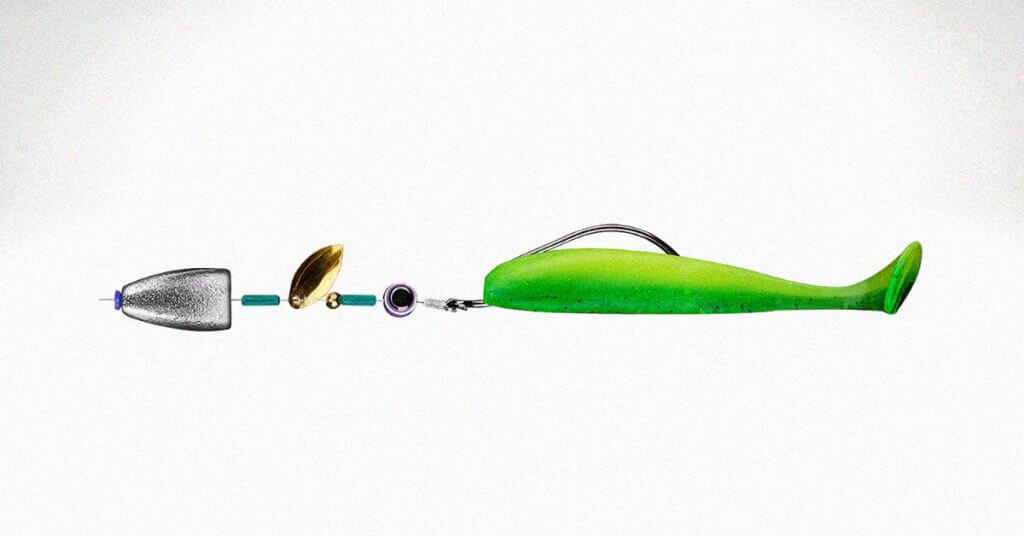
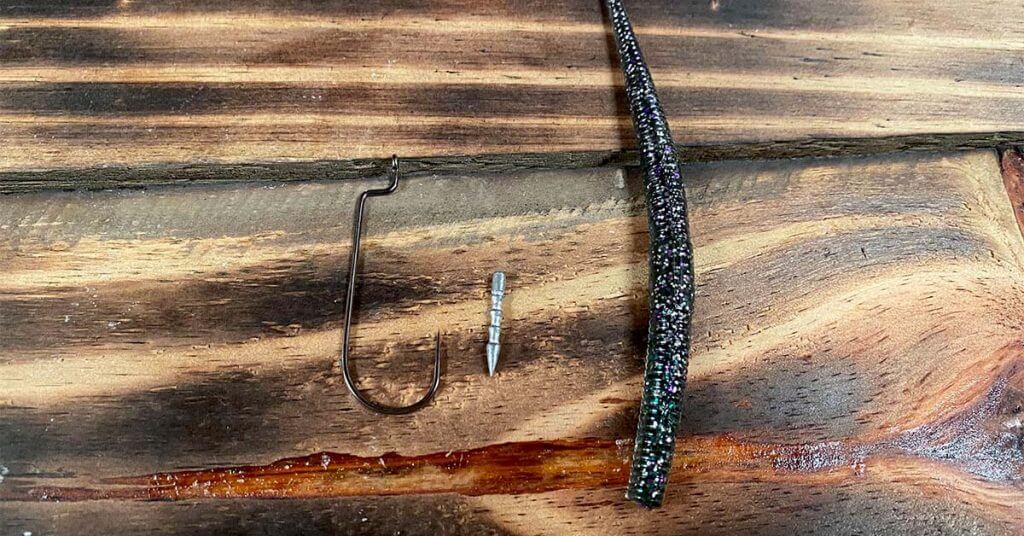
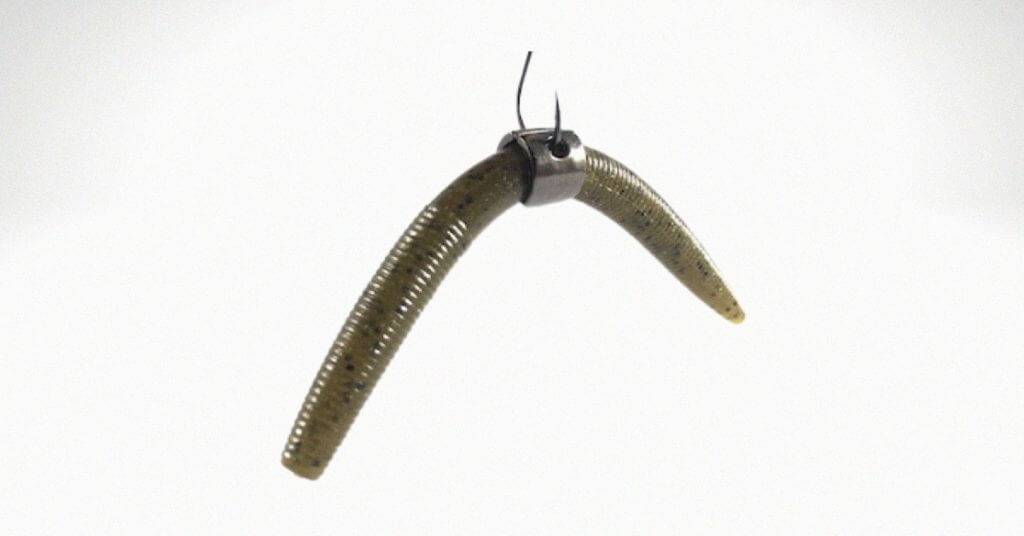
I’m unable to save this for my use!!! Can you send it to @ [email protected] for future use!!! Thank you!!! Any additional or future technics would be of great use!!!
Email coming to your inbox Kenn! Thanks for the comment!
Thanks. Nice, clear explanations! Just what I needed.
I appreciate you, thanks for reading!
Hello,
Great article for folks starting out. Question: why mono over braid? Most of the rigs you describe are slow moving and require sensitivity for bottom and bite detection. I would suggest no-stretch braided line to telegraph everything to the angler. Save mono for crank baits and other reaction baits.
Yup this is the page I’ve been looking for, time to drop a line. Do you find it necessary to have a leader line outside of a Carolina rig?
Thanks for reading Ben! I do think a leader is necessary for visibility purposes – it definitely helps with the presentation. I typically don’t run one longer than around 14 inches so you don’t have to go nuts with it. For some of the other rigs on here, you could definitely go without it but I think the Carolina requires it.
keep us up to date like this. Thanks for sharing.
And thank you for reading/visiting 🙂
Very well done! Straightforward and simple explanations. I appreciate you sharing this!
And we appreciate you reading and commenting! Thanks for the kind words Preston!